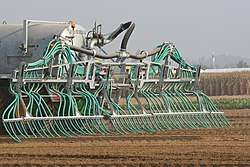Liquid manure
A development of the 20th-century Agribusiness age,[1] liquid manure is used as an alternative to fermented manure. Manure in both forms is used as a nutrient-enriched fertilizer for plants,[2] because farm animals excrete most of the nitrogen, phosphorus, and potassium that is present in the food they consume.[3]

History
Amy Bogaard, an archaeobotanist at the University of Oxford, suspects that even as early as the Stone Age farmers had noticed the improved fertility of manured land. Her team investigated European digs for crops of cereals such as wheat and barley, as well as pulses such as peas and lentils.[1][4] Modern-day scholars think that the Babylonian Chronicles and Egyptian hieroglyphs report manuring practices, while Pliny the Elder and Seneca the Younger describe similar Roman and barbarous Teuton practices.[1][3]
The Sallows photograph (dated 1906) in the Gallery shows a rear three-quarter view of a farmer driving a team of horses pulling a manure spreader in Huron County, Ontario.
The photograph in front of a barn (from 1941) shows how people in Iowa preserved the fertility of their land. A manure spreader is loaded and operated, which was not a usual or necessary practice on American farms of that era. No farmer had enough barnyard manure for all his tillage. This operator, however, puts all he has on the land and believes that it is worth his while to do so, since it acts to make a good crop better.
A gussied-up John Deere horse drawn manure spreader, located on display at Canton Power Equipment (46600 Ford Road, Canton, Michigan) in 2012, is shown in the full-colour modern digital photograph.
Current American fertilizer practice is relatively recent and dates back to the Post–World War II economic expansion era, when petroleum first began to be applied to agriculture.[1] Once powerful internal combustion engines, such as the diesel 4-cylinder 105 horse-power contained in the Fendt tractor depicted in the gallery,[5] allowed farmers to haul heavy steel tanks on twin-axle trailers rated for five metric tonnes around their fields, to liquefy the unfermented manure became feasible and a new commodity was born. As shown in the headline photograph from a 2009 Belgian trade show, liquid manure allows placement near the plant root and makes for a more efficient process. Of course, this necessitates large on-farm storage tanks, as seen at the end of the gallery.
By 2016, the hire of professional liquid manure applicators was commonplace, at least in Manitoba. The professional liquid manure spreaders had expensive professional liquid manure spreading equipment, and they were regulated by government to meet a rigorous set of standards. A professor said that for large livestock operations, "to rent the services of manure management planners and custom applicators" was most efficient, and any livestock facility with more than 300 animals must file an updated annual manure management plan with the regulator. Another fellow made nice coin on extracting phosphorus and nitrogen from liquid manure. He proposed the use of centrifuges to concentrate the nutrients.[6]
Gallery
- History of manuring practices
 Work of Reuben R. Sallows.
Work of Reuben R. Sallows. Iowan pre-agribusiness manuring implements
Iowan pre-agribusiness manuring implements- John Deere horse drawn manure spreader
 Post-agribusiness era liquid manure spreader trailered by a Fendt 310 tractor
Post-agribusiness era liquid manure spreader trailered by a Fendt 310 tractor_Liquid_manure_trailer_at_Haltgraben%2C_Frankenfels%2C_Austria.jpg) A liquid manure trailer at Haltgraben, Frankenfels, Austria
A liquid manure trailer at Haltgraben, Frankenfels, Austria- Anzio liquid manure trailer
 Houle 3150 liquid manure spreader in South Carolina
Houle 3150 liquid manure spreader in South Carolina Joskin brand liquid manure spreader at Werktuigendagen (2009)
Joskin brand liquid manure spreader at Werktuigendagen (2009) Liquid manure spreader from behind at Werktuigendagen (2009)
Liquid manure spreader from behind at Werktuigendagen (2009) Liquid manure tank in Belgium
Liquid manure tank in Belgium A liquid manure storage silo, located at Smilde Netherlands (2012)
A liquid manure storage silo, located at Smilde Netherlands (2012)
Role in disease transmission
Since at least 1982, health authorities have recognised that the O157:H7 organism, which has been responsible for significant numbers of human deaths, spreads through fecal transmission. The strain's low infectious dose, survival under adverse conditions, and potential for extreme disease severity prompt scientific attention. Radish, alfalfa sprouts, green onions as well as leafy green vegetables like lettuce, spinach are prone to be disease vectors, particularly when they are exposed to the pathogen just prior to harvest. In 1998, the Food and Drug Administration published the Guide to Minimize Microbial Food Safety Hazards for Fresh Fruits and Vegetables. Particular attention is paid to CAFOs because they are the source of most of the liquid manure that is spread on fields of vegetables. Rainwater runoff from these CAFOs was identified in the fatal Walkerton E. coli outbreak as the contaminant of municipal wellwater used for human consumption. Because of the relative infancy of industrial-scale vegetable fertilization by liquid manure, the process had not yet been nailed down by the year 2007, and included:[7]
- high-rate aeration
- low-rate aeration
- lagoon with high-rate aeration retrofit
- lagoon with low-rate aeration retrofit
- aerobic/anaerobic zones retrofit
- lagoon with impermeable cover
- lagoon with permeable cover
- anaerobic digester with gas collection
- aerobic biofilter
- sequencing batch reactor
See also
- Chicken manure
- Cow manure
- Manure spreader
- Slurry pit
- Feces
References
- "A historical overview of fertilizer use". Farm Journal, Inc. AgPRO. 23 March 2015.
- "Farmer's Handbook: Liquid Manure" (PDF). Permaculture News. Retrieved 2015-07-10.
- "Manure". Encyclopaedia Britannica.
- "Researchers Discover First Use of Fertilizer". American Association for the Advancement of Science. Science Mag. 15 July 2013.
- "Fendt Farmer 310". TractorData. Retrieved 8 July 2019.
- "Liquid hog manure is liquid gold". Glacier FarmMedia Limited Partnership. Grainews. 1 February 2016.
- "Reducing Risk of E. coli O157:H7 Contamination" (PDF). Nutrient Management Technical Note No. 7. USDA. September 2007.
External links
![]()